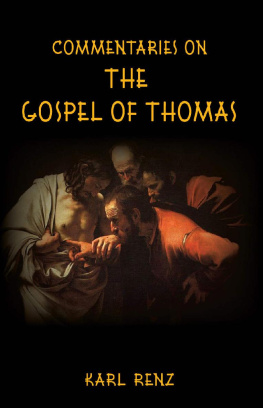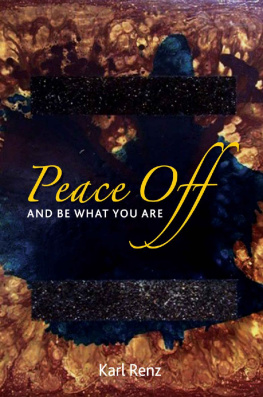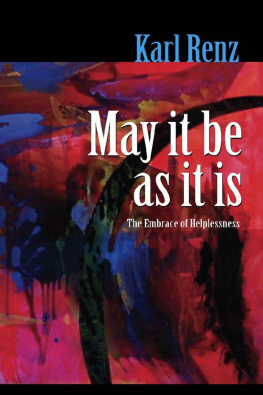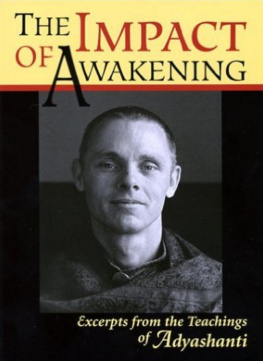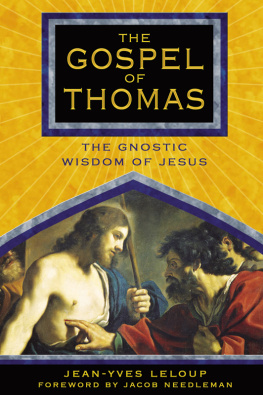

Excerpts from the Marsanne talks


C OMPILED BY
ANASUYA
E DITED BY
ANJALI WALSH

A D IVISION OF M AOLI M EDIA P RIVATE L IMITED
Commentaries On The Gospel Of Thomas
Excerpts from the Marsanne talks
Copyright 2015 Karl Renz
First Edition: December 2015
P UBLISHED B Y
ZEN PUBLICATIONS
A Division of Maoli Media Private Limited
60, Juhu Supreme Shopping Centre,
Gulmohar Cross Road No. 9, JVPD Scheme,
Juhu, Mumbai 400 049. India.
Tel: +91 22 32408074
eMail:
Website: www.zenpublications.com
Book Design: Red Sky Designs, Mumbai
Cover Image: The Incredulity of Saint Thomas, 1603, by the renowned artist Caravaggio
All rights reserved. No part of this book may be reproduced or transmitted in any form or by any means, electronic or mechanical, including photocopying, recording, or by any information storage and retrieval system without written permission from the author or his agents, except for the inclusion of brief quotations in a review.
C O N T E N T S

Other Books by Karl Renz
Undecided: Neti-Neti
A Little Bit Of Nothingness
81 Observations On The Unnamable
The Song of Irrelevance
Meditation of what you are
Heaven and Hell
Am I - I Am
May It Be As It Is
The Embrace of Helplessness
Worry and be Happy
The Audacity of Hopelessness
Echoes of Slience
Avadhut Gita Revisited
If You Wake Up, Dont Take It Personally
Dialogues in the Presence of Arunachala
The Myth of Enlightenment
Seeing Through the Illusion of Separation


I NTRODUCTION

D ISCOVERY OF T HE G OSPEL O F T HOMAS
A round 1945, in the area of Nag Hammadi in Upper Egypt, some peasants accidentally discovered some fifty-three parchments written in Sahidic Coptic buried in a large jar one meter high. Those leather-bound papyrus codices were mostly Gnostic texts, including the prestigious Gospel of Thomas: this manuscript is dated 4th century A.D. but quite possibly is a Coptic translation from Greek, the traces of which have been found in very damaged papyri discovered in Oxyrhynchus, Hellenic city of Middle Egypt, dated 3rd century A.D.
The Gospel of Thomas is composed of 114 logia (plural of logion) or sayings from Jesus, which reveal that the Kingdom is already present in each of us contrary to the canonical Gospels which advocate an apocalyptic psychosis in an eschatological context. This is because Gnosis, free from all religions, doesnt know any spatiotemporal otherworldliness.
Between the time when Jesus lived and the time when his words have definitely been fixed in the canonical Gospels, there have been multiple and deep reshuffles in the text, one can read in the introduction of Lvangile de Thomas translated from English and commentary by mile Gillabert, Pierre Bourgeois and Yves Haas. The original English translation quoted in this book is by Thomas O. Lambdin and has been chosen due to its earnestness and authenticity. Meanwhile our humble Gnostics were meditating on the WORDS that since Thomas their scribes had faithfully been recopying on new papyri as soon as the old ones started to wear out. Until the day when, threatened by destruction as the result of their non-submission to the Judeo-Christian proselytes, they decided to preserve, if not their lives, at least their library, including of course the Thomas Gospel - which was the most important document - in its last and truthful copy. Thus, this treasure was entrusted to the Earth for some fifteen centuries
No need to say that this discovery brought up a lot of polemics especially as at least half of the 114 logia are not to be found in the Gospels of the New Testament and those which do appear there are never exactly the same. Very different from the canonical Gospels, this remarkable text, which identifies Jesus as a Gnostic, is inviting us to a discovery of ourselves by ourselves through Life itself, which is our reality. Thus Christians and Gnostics are separated by an abyss. In the Christian tradition Gnostic texts have been banned and destroyed, and the texts found in this jar appeared on the list of a decree from bishop Athanasius of Alexandria ordering their destruction
Today the discovery of the parchments from Nag Hammadi enables us to hear the voice of the Gnostics, victims of persecutions, whose writings strongly emphasized the primacy of individual direct experience.
D IDYMUS J UDAS T HOMAS
I t is said in the Prologue of the Gospel of Thomas : These are the secret sayings, which the living Jesus spoke and which Didymus Judas Thomas wrote down. In his commentaries, mile Gillabert writes concerning Didymus Judas Thomas: The disciple habitually called Thomas is called here Didymus Judas Thomas, name not unknown from the Gospel of John. Didymus (Didumos in Greek) means twin. This word probably refers to the quality and privilege of confidante and revealer of Jesus message: As twin, Thomas is somehow Jesus alter ego. Regarding Judas, mile Gillabert spoke in length about this character to whom he has dedicated a book: Judas, tratre ou initi (Judas, traitor or initiate).
T HE M ETANOA A SSOCIATION
mile Gillabert has been particularly fascinated by the Gospel of Thomas. He used to say that in India, Japan and China, there has been a plethora of non-dual texts while those were lacking in Western cultures. The discovery of the Gospel of Thomas has been providing the proof that Jesus uttered non-dual words attesting to the same awakening as the great sages of the East. Thus the source was also to be found in our Western tradition but had been concealed by centuries of theology. This is why mile Gillabert has been rather particular on the correct French translation of this text in the light of the universal Gnosis, that is to say of the non-duality, so much so that he founded the Metanoia association whose purpose is to explore the Gospel of Thomas in depth as well as to make it known.
K ARL R ENZ
A few decades after mile Gillabert death, the Metanoia association had the fortunate inspiration to invite Karl Renz on four occasions, in 2003, 2005, 2008 and 2010. During those informal and spontaneous conversations, the participants had the opportunity to present to Karl a large number of logia in order to spark off his commentaries. This book tells the best part of those commentaries revealing Karls responses to his questioners while expressing, over the course of the talks and in his unequivocal manner, the living Word which he so clearly embodies.
Whilst Karls commentaries directly respond to each logion, they also answer participants questions as they naturally come up and this free flow (which follows on from each logion as a spider web which is spun and then tightens itself) takes hold of the one who is exposing himself by blocking off all possible escape routes, thus creating an unconventional non-dual echo of the true Gnosis.
Next page
